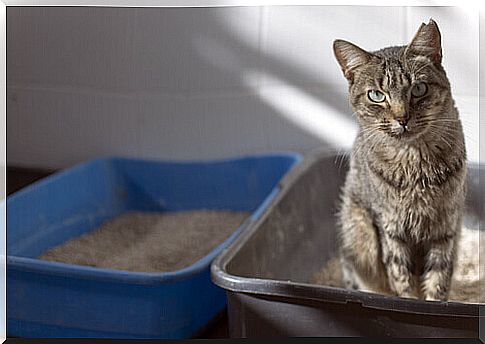Diseases Of The Urinary Tract In Cats

Cats are prone to suffer from some bladder and kidney problems . Therefore, it is very important to know how to identify such ailments in order to be able to cure them in time. In the following article we will tell you everything you need to know about urinary tract diseases in cats.
What to know about urinary tract diseases in cats?
The infections of the urinary tract are very common in cats and can be quite annoying and painful for them. Unlike dogs, felines drink little water and their urine is more concentrated. These are the main reasons for their vulnerability to this type of disease.
There are three diseases that most affect the urinary tract: urolithiasis (urinary stones), nephritis (kidney inflation) and cystitis (inflammation of the bladder). Since the symptoms are similar, the different diseases are often confused and only the veterinarian is able to establish a definitive diagnosis.
To know if your cat has a urinary tract infection, you need to pay close attention to the possible signs it presents. Unfortunately, in some cases, the symptoms are so mild that they are unnoticeable. Check, as much as possible, the behavior of your pet when he does his toilet and uses the litter box.

In the case of a urinary infection, they are likely to make a lot of effort to urinate. In addition, it may be that the animal excretes very little liquid or that it expels its waste out of the litter box. Even more evident is the case in which the cat cries or meows, forcefully, while urinating. In a more advanced stage of the infection, it is normal to notice the presence of blood in the fluid with a rise in body temperature up to fever.
Diseases of the urinary tract in cats: diagnosis and treatment
Although these conditions can appear at any time in life, they are more common in adult cats or among those suffering from obesity. Urinary infections also develop in animals that are neutered or that live in very small spaces, therefore more prone to suffering from anxiety or stress .
To diagnose the problem, in addition to analyzing the symptoms, it is very important to take the animal to the vet. After having subjected the animal to various tests, including blood and urine tests, the trusted specialist will be able to assess its condition very precisely.
Treatment will depend on the type of infection and the characteristics of your cat. However, antibiotics or other drugs should be given in most cases to relax the urethra and prevent new blockages in the urinary tract.
When the disease situation is particularly serious, the vet may insert a catheter – after anesthetizing it – to allow urine to flow easily. Subsequently, fluids will be given intravenously. Your four-legged friend is likely to have to stay in the hospital for at least two days.

Prevent urinary tract infections in your cat
Once the animal has been cured of the infection, the next step is to avoid possible relapses. As a first step, educate him to drink more water so that he will be able to expel toxins from the body more smoothly.
Consult your vet to find out what are the best feed and wet food options for a cat with such urinary problems. He will prescribe specific recipes for baby food low in sodium, a component that hinders the normal activity of the kidneys.
It is very important to clean the litter box every day so that bacteria and viruses that cause infections do not proliferate. It is about offering the cat a peaceful and happy life to avoid anxiety or stress.
In addition, we recommend that you play a little more with your pet to keep him fit and avoid an overly sedentary lifestyle and, even worse, obesity. These two are the worst enemies for domestic feline urinary health.
Of course, as soon as you notice symptoms of one of the urinary tract diseases or a change in your pet’s behavior related to the use of the litter box, you should take him to the vet right away. It is important that the specialist examines it to make an early diagnosis. Do not wait for the cat to heal “by itself”: a delay in treatment could cause serious health problems for the cat at home.









